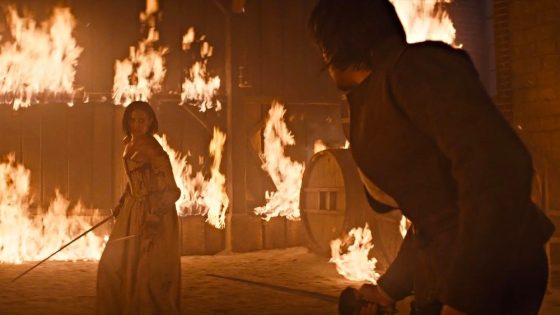For readers of Alexandre Dumas’ novel, extravagant French adaptation “The Three Musketeers – Part II: Milady” packs its share of surprises: killing off important characters, sparing others and reimagining allegiances that have stood for nearly two centuries. For viewers of “Part I: D’Artagnan,” however, this swashbuckling sequel feels totally in keeping with what has come before. Even the twists track, paying off what amounts to a nearly four-hour investment (not counting however many months audiences may have waited to see how the story ends).
Loyalty — to the crown, to one another, but not necessarily to the source material — remains the driving theme of director Martin Bourboulon’s blockbuster treatment, which tapped French megastars Vincent Cassel, Pio Marmaï and Romain Duris as titular trio Athos, Porthos and Aramis. The second film opens with fourth musketeer D’Artagnan (François Civil) in a coffin, though he’s not dead, merely captured by traitors who’d like to see King Louis XIII (Louis Garrel) dethroned. His beloved Constance Bonacieux (Lyna Khoudri) has been kidnapped, and D’Artagnan soon discovers that his most promising ally in rescuing her is none other than the duplicitous Milady (Eva Green).
It feels only right to place Milady’s name in the title here, given not only the prominence of her part, but also the expansive way in which screenwriters Matthieu Delaporte and Alexandre de La Patellière have reimagined her motives. Since Dumas first conceived her, Milady has stood as one of the great female villains in all of literature: sly, seductive and fiercely independent. Over the decades, the cunning femme fatale been played by Lana Turner, Faye Dunaway and even Milla Jovovich (in her husband Paul W.S. Anderson’s best-forgotten version), though Green seems like the perfect choice by today’s standards.
Culturally, France has lagged behind the United States in its embrace of the #MeToo movement, and yet, “Milady” reflects the temperature of the time, recasting this dark temptress as a victim, misunderstood and mistreated by men. “Since I became a woman, their hands took me, soiled me, betrayed me,” she swears at one point. In the novel, Milady murders multiple people, including Constance, though the movie seems determined to make her less evil, if not downright justified in her thirst for vengeance. It also softens the book’s primary antagonist, Cardinal Richelieu (Eric Ruf), effectively diluting the looming risk of war between the Protestants and his forces.
Bourboulon isn’t the first filmmaker to split Dumas’ novel down the middle. Half a century earlier, Richard Lester directed back-to-back features, called “The Three Musketeers” and “The Four Musketeers” — though the latter was rechristened “They Call Her Milady” (“On l’appelait Milady”) in France, suggesting a precedent for accentuating Green’s character in the second half. She’s an infinitely more interesting source of obsession for D’Artagnan than Constance, who comes across as beatifically banal as played by Khoudri here. That in turn makes D’Artagnan’s efforts to rescue her seem rather uninspired, as if he could be doing something better with his time — like lusting after Milady.
In this telling, Constance accidentally stumbled upon the perpetrators of the plot to assassinate the king just before Part I ended, which at least imbues the character with a certain value. Still, it’s far more exciting to see D’Artagnan and Milady together, as they are early on, fighting side by side for a change (the first scene of the first part found D’Artagnan protecting what looked like a damsel in distress, only to have Milady pull a gun on him, whereas here, they’ve got one another’s backs). Bourboulon’s big innovation in these films can be seen in his action sequences, which typically unfold via elaborate oners — dynamic set-pieces designed to look as though they were captured in a single unbroken shot.
During an early escape, the cameraman chases after D’Artagnan, running along the lofty fortress parapet. When the young hero finds himself cornered, the lens pivots left, then right, pulling back for a moment’s hesitation before plunging right behind D’Artagnan into the moat. The effect is far more immersive than most adventure movies, which use quick cutting to place viewers in the fray. The way DP Nicolas Bolduc shoots these well-choreographed, minimally edited sequences, we feel like participants in the action, as in a knife fight that comes just a few scenes later, where the nimble camera is at knee level when D’Artagnan drives a blade through his opponent’s leg.
The other musketeers have less to do this time around, though each remains sworn to protecting the honor of others. Porthos has fallen in love with Aramis’ sister, Mathilde (Camille Rutherford), and together the two confront the cad who took advantage of her. In a rather confusing (but nonetheless exciting) subplot, Athos risks his life to rescue a comrade strapped to a wooden cross. He too has unfinished business with Milady — which remains the case all the way to the end, suggesting a thread that could inspire an off-canon “Part III,” should Bourboulon care to continue the epic.
Sadly, the filmmakers have sunk nearly $80 million into the project so far, and though it performed well in France (“D’Artagnan” was 2023’s third highest earner at home), admissions dipped by 25% between the first and second installments. In the U.S. and elsewhere, the films have hardly enjoyed the drawing power of a comparable Hollywood blockbuster, suggesting that French action movies don’t travel as well. That’s discouraging, seeing as how the film represents a welcome alternative to the type of IP driving American franchises these days: mostly toy brands and comic books. The two films boast dozens of stunning historic locations, as Bourboulon treats us to a tour of some of France’s most scenic chateaux, with a detour to Buckingham Manor along the white cliffs of Dover.
Stateside, subtitles tend to relegate movies to specialty venues, where the kind of young audiences most likely to appreciate this grand-scale adventure rarely congregate en masse. This is megaplex entertainment at its most grand, but it would take some clever marketing to transform what looks like an art-house movie into a “Parasite”-style phenomenon, even if both well-made offerings share the same quality: They fill an entertainment niche that American movies have all but abdicated.
Source Agencies



